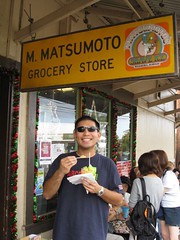 It’s fun coming up with business ideas. Whenever inspiration strikes me, I’ll often tweet it. Just because. (I’m not one of those people who believes ideas need to be hidden and sheltered.)
It’s fun coming up with business ideas. Whenever inspiration strikes me, I’ll often tweet it. Just because. (I’m not one of those people who believes ideas need to be hidden and sheltered.)
Since the last time I listed all of the ideas I’ve tweeted, I’ve had a ton more. It’s not easy to search through one’s Twitter feed unfortunately. It appears to be limited to a week or two of previous tweets. Instead, I used FriendFeed to put together this list.
This is mostly for my own benefit, though perhaps this will inspire someone to go create someone wonderful. Also, I find it amusing how some of these ideas exist now. (And how stupid some of them are.)
Biz ideas from Mar – Dec 2009
- How about a site that creates stock portfolios from companies that match the principles from biz books e.g. http://ow.ly/1K9G 30 Mar 09
- Nose plugs for runny noses. Oh wait, it exists already! http://tinyurl.com/cgqprk 31 Mar 09
- Re-branding energy bars (eg Cliff bars) as a quick portable meal for busy on-the-go working professionals 4 Apr 09
- Scalable network of food & history tours in major culinary cities. Indie ones exist already, how about a streamlined nat’l op? 8 Apr 09
- Niche airline for obese passengers. I’m listening to an NPR report on this topic right now. 20 Apr 09
- User-friendly apps for doctors (eg patient data, scheduling, etc). Seeing their awful apps just begs for change. Tough biz tho. 21 Apr 09
- Weight Watchers-type cuisine w/ specific cultural dishes (Chinese, Japanese, Indian, Brazilian, Mexican, etc) instead of just U.S. 3 May 09
- A Hawaiian shave ice-type shop in inland southern CA (the desert). And maybe NV & AZ too. 4 May 09
- The Cat Whisperer (hey, we have one for dogs, why not cats too?) 16 May 09
- A marketing app that retrieves census data & allows marketers to easily parse, filter, dissect, & analyze this info. 21 May 09
- Gas stations that sell drinks at the pumps (hot coffee, smoothies, sodas, etc). I’d buy one right now 18 Jun 09
- To the 24/7 diners near Apple stores, hand out free coffee & placeholder placards to people in line, so they can get breakfast 19 Jun 09
- Law & Order-type show w/ real stories based on 1st responders (firefighters) or 911 operators 28 Jun 09
- There’s a restaurant dedicated to garlic (The Stinking Rose), how about one w/ chocolate? Appetizers, entrees, drinks & desserts! 11 Jul 09
- Restaurant selling foods on a stick, like BBQ ribs, fried onion rings, corn, etc. Hmm I think this exists already, huh? 22 Jul 09
- Public pools for dogs. Could be attached to doggie day care & allow owners in there too. Costs might be too high tho. 21 Jul 09
- Dog tattoos using permanent marker on hairless or shaven dogs 5 Aug 09
- A dog training class that teaches funny & cool tricks only, like combat crawl, peek-a-boo, get beer, etc. 5 Aug 09
- Wifi at a dog park or dog beach, tho perhaps I’m the only person who would use it 9 Aug 09
- Feature idea for online music sites: Display the lyrics to the song while playing it. Kind of surprised no one’s doing that. 31 Aug 09
- iPhone app idea: a blog publishing app with Flickr Creative Commons + iPhone camera integration for adding images easily. 28 Sep 09
Biz ideas from Jan – Dec 2010
- An online video editor that can make VH1 Pop-Up Videos & karaoke videos, a la Yahoo Jumpcut (RIP) 7 Jan 10
- How about an app that does market research using social media? http://bit.ly/6ViI4l 21 Jan 10
- A computer game that lets you create your own playable games. Could allow extensions/plugins/mods too. 24 Jan 10
- Idea for Google Maps: You know what would be cool? Time estimates based on traffic density 26 Jan 10
- Postal service in airports, especially tourist spots for over-packers. Think I’ve seen this before. Maybe it’s not viable. Hmm. 26 Jan 10
- Location tracking service w/ sync to environmental data. Bill Davenhall would sure love it. http://bit.ly/bhBaUn 27 Jan 10
- For ex-media professionals, how about offering media training to execs & entrepreneurs? 31 Jan 10
- Communication reader & writer for private (email,IM) & public (social media) convos. Like Gmail + Meebo + Hootsuite 17 Feb 10
- Real-time geotagged emotions. What I’m feeling right here, right now. http://bit.ly/9yeZLd 20 Feb 10
- Online mix-tape maker (basically, song lists). Could be a feature of Pandora or Last.fm too. 2 Mar 10
- A site for iPhone text message typos. Not quite a money maker, but perhaps a fun ‘lil meme. 13 Mar 10
- Idea for CoTweet & HootSuite: An undo feature, similar to Gmail’s. So I can fix misspellings before publishing a tweet. 17 Mar 10
- Hawaiian shave ice franchise (finely shaved ice, flavored syrup, sweet red beans, sweetened condensed milk & ice cream) 26 Mar 10
- Minute to Win It home game, for birthday parties, baby showers, etc. (and potentially, practice) 28 Mar 10
- App that uses Twitter data as a prediction market for movies, games, politics, etc http://bit.ly/aLwakF 2 Apr 10
- Service that rewrites & publishes legal, medical & business docs in simple terms http://bit.ly/9wHsJE 4 Apr 10
- An app/extension that allows you to do a text search thru your browser history & cache 8 Apr 10
- Twitter $ Idea: Fee-based subscription to old data (tweets older than 2 weeks). Good or bad idea? 10 Apr 10
- Game Idea: 3D maze, where you can move in X, Y & Z planes. 15 Apr 10
- A cord that connects your mobile device to your belt, so you don’t accidentally lose your device. 19 Apr 10
- A service that examines your tweets & analyzes how they’ve evolved over time (readability, style, content, etc) 29 Apr 10
- A niche video site just for Legos videos. Just because. 5 May 10
- Getting real-time traffic data via crowdsourcing through mobile apps that measure location, direction & speed 12 May 10
- Social media data mining. Not just influencers, but purchase/harm/etc intent, prediction mkts, trends, matchmaking, etc 26 May 10
- TV Show Idea: Drama/comedy in real-time 24 style, even with “real” tweets coming from characters as they happen 27 May 10
- Twitter music reviews. Lots exist for movie reviews already, why not music too? 28 May 10
- A beach pillow that allows you to lie face down without suffocating, like those on massage tables 31 May 10
- A white-label, self-hosted user account management system for web apps, similar to Chargify 3 Jun 10
- Twitter movie review site idea: Track the buzz of upcoming movies & compare it to the actual reviews 4 Jun 10
- A distributed social network based on blogs, RSS, microformats & shared standards, and a MyBlogLog-like “platform” 7 Jun 10
- Idea: A browser extension that allows you to change the font color on a page or site. 10 Jun 10
- An app that aggregates IM chat archives (online & desktop) and makes them searchable in one place. 14 Jun 10
- Idea: Give customers an easy 1-click way to praise your customer facing employees. 24 Jun 10
- A mattress w/ varying firmness AND varying temps, for guys who are always hot & girls who are always cold 17 Jul 10
- Combine Nike’s NIKEiD + Lego’s DesignByMe premise with IKEA to get design-your-own furniture (color, size, etc) 26 Jul 10
- Idea: A band that sings rap songs & raps pop songs, a la Dynamite Hack’s “Boyz N The Hood” 2 Aug 10
- An all-in-one message & comm center that lets you see, read & send emails, IMs, tweets, Facebook posts, etc 4 Aug 10
- Idea for @thechive: Make an app where ppl can select a Jenny DryErase pic, type in some words to appear on the board, then export the img 11 Aug 10
- App that combines friends’ upcoming birthdays + a shopping list 19 Aug 10
- A gaming platform that builds social games on both Facebook & iPhone 7 Sep 10
- Idea for Facebook: Allow people to check in to activities, like “Mike and Mia are playing Words with Friends” 21 Sep 10
- Game Idea: A choose-your-own-adventure-type game over IM w/ intelligent IM bots 5 Oct 10
- Purchase SlowNewsDay.com & allow readers to submit URLs of boring news stories & comment sarcastically on them 8 Oct 10
Biz ideas from Jan – July 2011
- Minute-to-Win-It Bootcamp. Wait, wut? It exists already? Damn. 19 Jan 11
- Fitness mobile app w/ timed checkins, so you have to jog/run from place to place for badges 14 Feb 11
- A travel deal finder. Enter your home city, free dates & max price. Then it finds every worldwide deal that matches 2 Mar 11
- A wrist strap on baby utensils, so they don’t fall to the ground when the young’uns drop them 26 Mar 11
- A trip planner that lets you plan with both a map view & calendar view. 23 May 11
- A Mint-like service that manages all the merchant discounts one can get from their credit cards, memberships, etc 6 Jun 11
- Social Engineering Security Consultants http://bit.ly/kNg8YB 9 Jun 11
- “Turn your iPhone into a taser” extension case. Um, or maybe not. 11 Jun 11
- Location review & advice service that uses your 1st & 2nd degree social network, perhaps with a Q&A format 15 Jun 11
- A restaurant review service that learns, then finds matches based on your individual preferences. 17 Jun 11
- A tool to help recruiters source software developers from sites like GitHub, StackOverflow, etc http://bit.ly/jyN3i1 23 Jun 11
- A Hawaiian Shave Ice shop in some hot town on the mainland. 29 Jun 11 (How funny; I apparently have this idea about once a year)
- An easy way to create an ebook out of selected articles & blog entries. Copyright & monetization would be tough tho. 11 Jul 11
- Limited range group messaging using transceivers, to replace people walkie talkies during camping trips. 27 Jul 11
- A Manpacks.com for toiletries, like contact lens solutions, toothpaste, shampoo, etc. 30 Jul 11
Want to see more business ideas? Want to discuss business ideas? Follow me on Twitter at @mikeleeorg! </plug shameless=”yes”>





